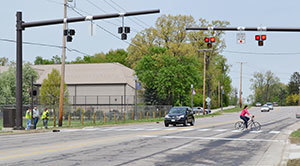
The University of Notre Dame, in cooperation with St. Joseph County, has installed a new type of traffic signal that has been proven to increase pedestrian safety when crossing the street. The new signal is known as a “HAWK” signal, an acronym that stands for high-intensity activated crosswalk.
The HAWK signal has been installed near the intersection of Twyckenham Drive and Vaness Street, the first of its kind in St. Joseph and Elkhart counties. HAWK signals were developed by the city of Tucson, Ariz., in 2004. They have since been installed by many other states and in Washington, D.C.
By installing the HAWK signal, the University is bringing proven technology to the campus area to enhance pedestrian safety. Studies have shown that more than 90 percent of motorists properly yield to pedestrians in crosswalks using HAWK signal. The HAWK signal at Twyckenham Drive is replacing a traditional pedestrian crossing. It will be more effective at increasing motorist awareness of pedestrians in the crosswalk.
When not in use, the HAWK traffic signal is dark to motorists, and a solid orange raised hand indicating “Don’t Walk” is displayed for pedestrians. When a pedestrian pushes the crosswalk button, motorists see a flashing yellow signal for several seconds. After the flashing yellow interval, the traffic signal displays a solid yellow — much like a conventional traffic signal — alerting motorists to get ready to stop.
Much like traditional traffic signals, the walking person symbol soon changes to a flashing orange hand with a countdown display showing the number of seconds left to cross the street. As with all pedestrian crossing signals, pedestrians should not start crossing the street if the flashing orange hand and countdown timer is showing. During this time, drivers see alternating flashing red signals, like at a railroad crossing signal. When the flashing red is displayed, drivers may proceed after stopping if there are no pedestrians in the crosswalk.
The cycle ends with the flashing red signals going dark and the solid orange raised hand shown to pedestrians until the next pedestrian pushes the button.
Contact: Tim Sexton, associate vice president for public affairs, sexton.30@nd.edu